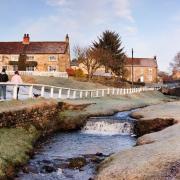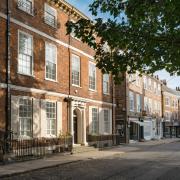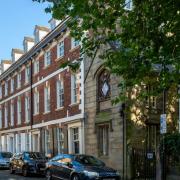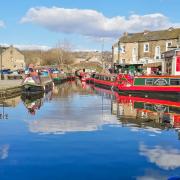If you’re thinking of a move to Whitby, the good news is that there’s plenty of property for sale, and much of it at affordable prices. The bad news – for some of you at least – is that you’ll almost always have to share your beloved town with tourists. Visit Whitby on a rainy Tuesday morning in November, and you’ll still bump into them. But who can blame them? Why wouldn’t they want to visit this gloriously quirky seaside town, flanked on one side by the stunning landscapes of the North York Moors National Park, and on the other by the wild North Sea?
Tourists have flocked to Whitby for centuries, including writers Lewis Carroll and Bram Stoker. The former visited Whitby regularly between 1856 and 1871 – it’s said that his nonsense poem The Walrus and the Carpenter was inspired by his walks on the town’s beaches.

Bram Stoker took a week’s holiday in the town in 1890 after a particularly tough theatrical tour – his boss, actor-manager Sir Henry Irving, recommended it as a good place to rest and recharge. Little could he know that that week’s wanderings around the winding streets would provide the spark for one of the greatest gothic novels in the English language – Dracula.
Whitby is a town rich in history and heritage, art and culture, industry and tourism. If shopping is your thing, you’ll find few chains; the town is thronged instead by fascinating independents (with a nice mix of touristy outlets alongside the kind of shops you actually need).
There’s plenty to feed the soul, too: great restaurants and pubs, a decent theatre with live shows and films, and throughout the year, a pageant of festivals, from music to the annual Whitby Regatta.

Explore
You could spend a lifetime exploring Whitby, and still not exhaust its possibilities. Let’s start with the obvious – on the East Cliff, there’s the world-famous Abbey whose gothic silhouette dominates the town. Alongside it, St Mary’s Church with its fabulous 18th-century box pews, three-layered pulpit, and strong connections to the town’s lifeboat community. In the churchyard – famed amongst those who enjoy the dark side as the place where Dracula took his first victim on English soil – is a cross commemorating Caedmon, widely regarded as the first English poet.
From there, the famous 199 Steps lead down to, on the right, Henrietta Street, home to historic Fortune’s Kippers, and to the left, Church Street, a picturesque cobbled lane lined by jet works and shops and the town’s former Town Hall.
Beyond this busy area, wander along the riverside (maybe via the Captain Cook Museum on Grape Lane) to the Seamen’s Hospital, decorated with an ornate balustrade and statuary, all topped by a fully rigged model sailing ship.

Phew – so much history, so little time! And we haven’t even crossed the river yet. Do so via the swing bridge – if you have to kill a bit of time while it opens to let a tall-masted boat through, so much the better: it’s a spectacle in its own right.
On the west side, wander down towards the piers, past the newly opened Whitby Lobster Hatchery. At the bandstand, pause to decide between a breezy stroll along the pier, or a climb up the Khyber Pass to the West Cliff, home to the whalebone arch, and Captain Cook’s statue. Walk down Skinner Street, with its many independent shops, leading to Flowergate, where you can take a vertiginous walk back down to the harbourside, or go a little further uphill to find the beautiful Whitby Museum and Pannett Art Gallery.
And all that before we even touch on Whitby’s architecture (the remarkable ‘bottle’ windows were said to be a solution to the window tax); the extensive yards, alleyways and ‘ghauts’ that riddle the town (explore by all means, but remember that many are still residential, so be respectful); fossil hunting; the town’s importance role in the whaling industry of the 18th and 19th centuries… tired of Whitby? You must be tired of life!

Bag a property
Whitby has a nice mix of properties for sale, and at affordable prices. Looking for a one-bed flat in a converted landmark Victorian hotel, complete with balcony and sea views? It’s yours for just £150,000. If you’re climbing the property ladder, there are plenty of new-builds available on the outskirts, with prices generally in the £300,000-£400,000 range for three to four bedrooms. Or a gorgeous Grade II listed Georgian townhouse with seven bedrooms will set you back just £895,000.
Whitby is only reachable by train via Middlesbrough, or, in the summer months, by steam train from Pickering. It’s a half-hour drive from the next biggest centre of population, Scarborough. Travel by car is probably the most convenient way to get to Whitby, but that does mean that parking can be at a real premium in the busier months.

Town Life
Lois Borrett is the great-great-granddaughter of Botham’s Bakery founder Elizabeth Botham, and heads up the bakery’s Finishing Room.
‘When the sun’s shining and the Whitby lemon buns are iced, you’ll find me at the family beach hut – summers for the Botham family are all about the beach! We’ve lots of tricks up our sleeves for beach hut days – pre-slicing and buttering Heritage Ginger Loaf is our top hack. And you’ll always find our Resolution Tea in the hut for post-dip warm-ups.
‘We like to make the most of Fusco’s Royal Fisheries’ app to pre-order fish and chips, or order pizza from the clifftop Pizza West: surf and a slice!
‘My role includes product development, and I personally love Whitby Sea Salt. We use it in many of our bakes; most recently I created a Whitby Sea Salt & Caramel Biscuit for May’s Fish & Ships Festival.’



























